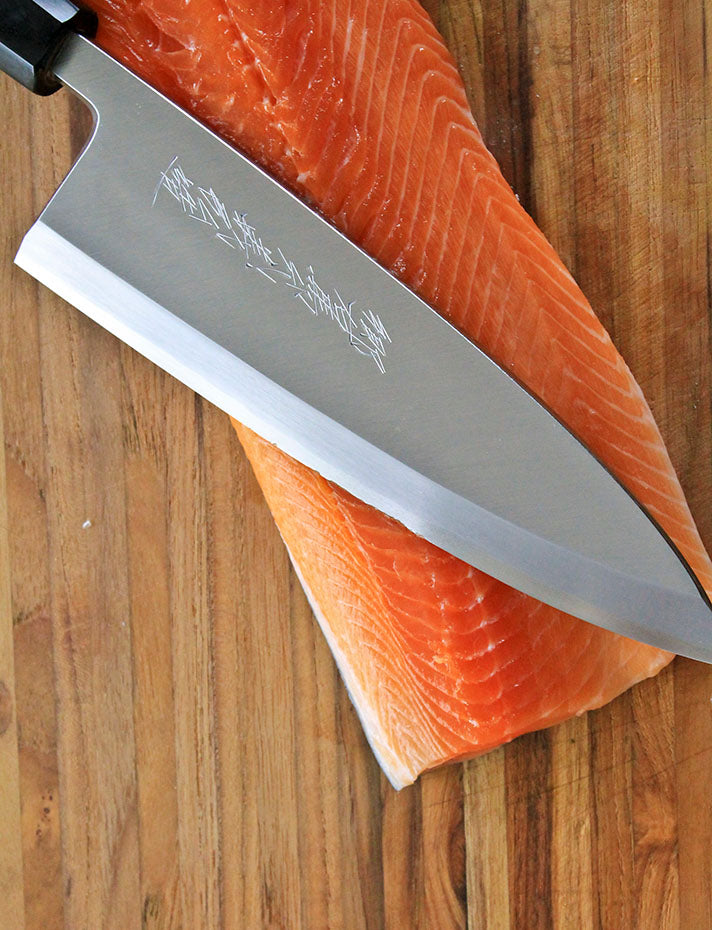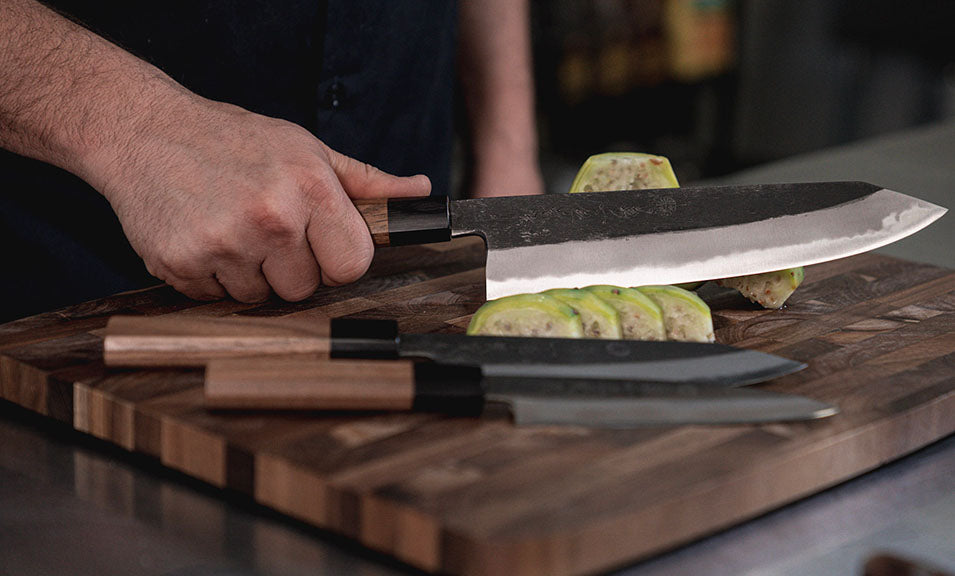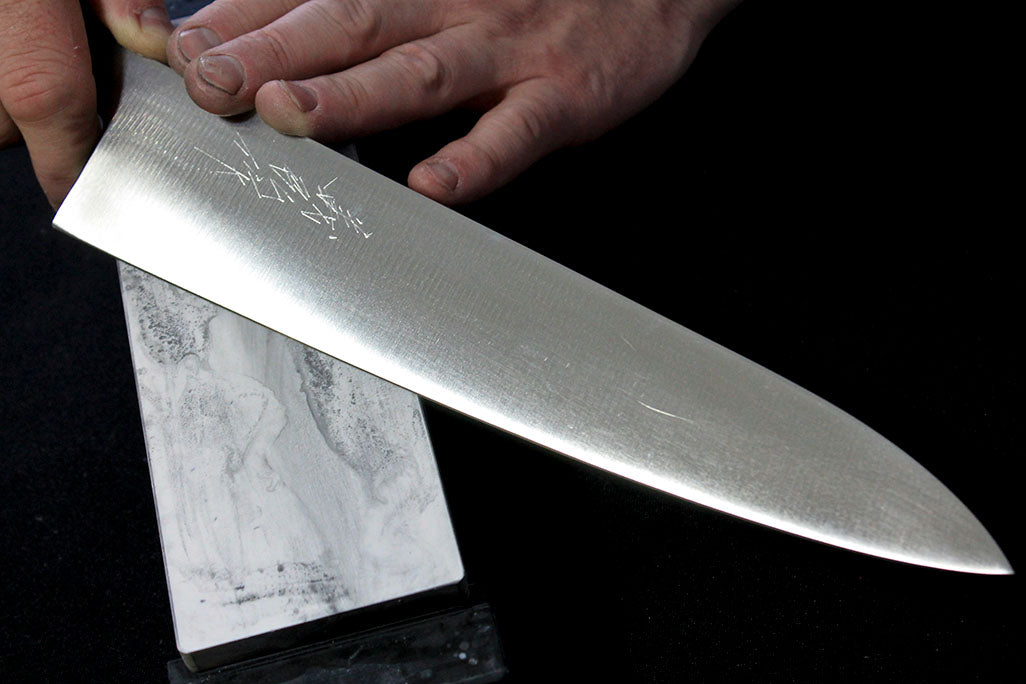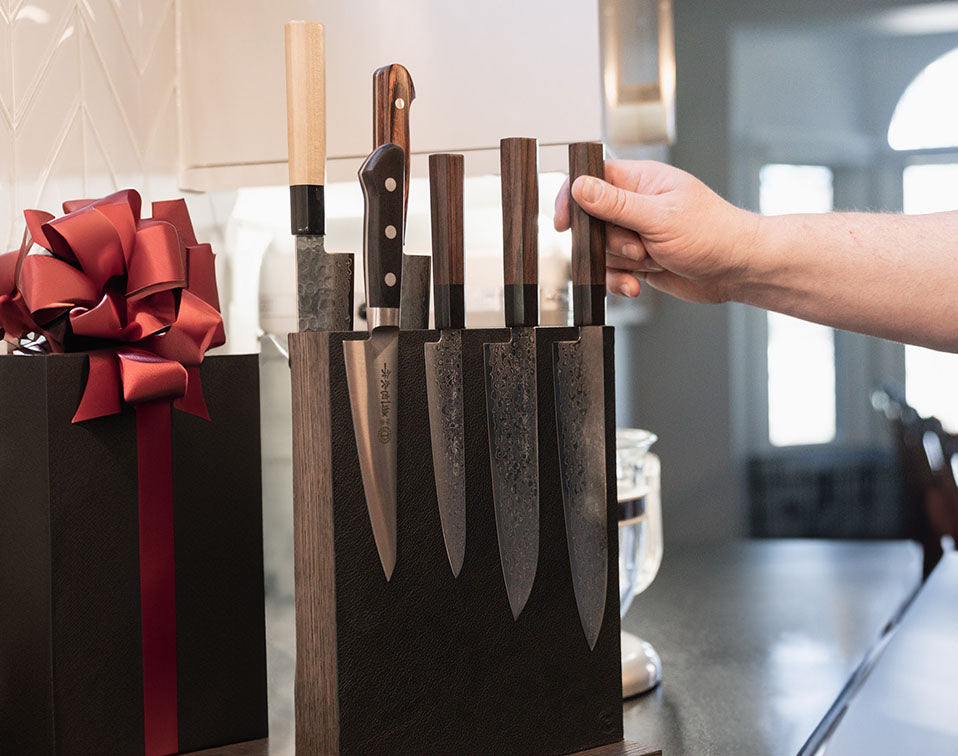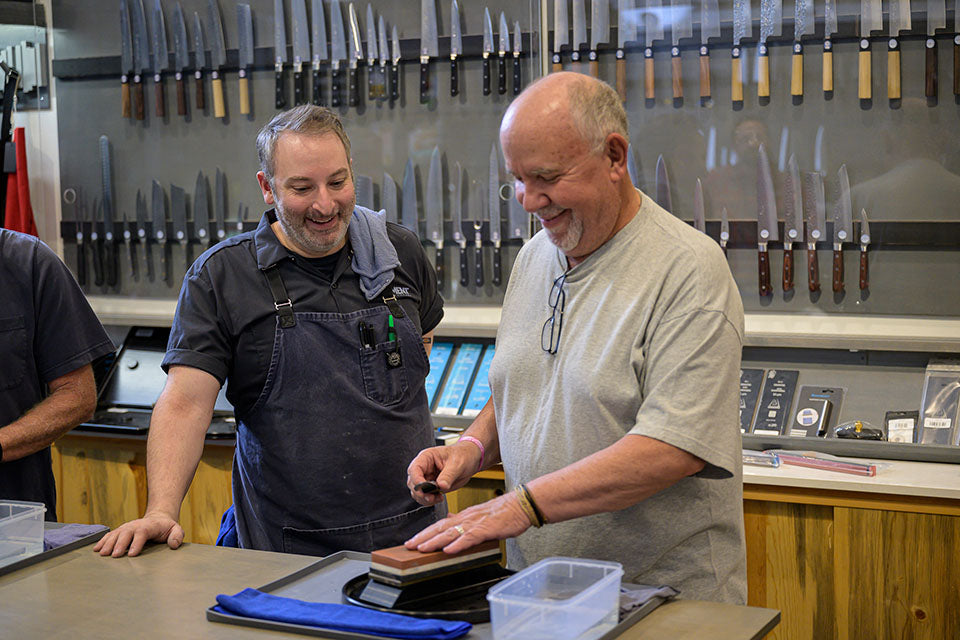Knife Care

Knife Care
Dos & Don'ts
This section aims to help you preserve your knife's sharpness and quality, ensuring it remains a reliable tool in your culinary arsenal for years to come.

Knife Care Basics
Don’t move food products on your cutting board by scraping the knife’s edge.

Knife Care Basics
Always maintain a sharp edge!

Knife Care Basics
Never use your knife as a screwdriver or hammer.

Knife Care Basics
Never put your knife in the dishwasher.
Knife Care
Knife Storage & Organization
On the go or in your kitchen, organizing and protecting your investments is important. Everyone's kitchen spaces and needs are different. Learn about edge guards, knife rolls & bags, magnetic strips, knife blocks, and in-drawer options.

Knife Storage And Organization
Knife Guards
Knife Guards come in different styles. Some cover the blade by inserting it from the end. Others slip over the knife from the edge. Guards can be made from an array of materials like plastic, wood, or leather. Protecting the knife's edge is important when placing knives into chef rolls or knife bags. This keeps the sharp edges from banging around and protects fingers as well as damage to the bags. Furthermore, if knives are going to be stored in a drawer without an in-drawer knife organizer, it's a good idea to put edge guards over them.

Knife Storage And Organization
Knife Luggage
Knife luggage comes in a variety of options, Rolls, Bags & Backpacks. These are great options for people on the go. Always protect your fingers, knives, and luggage with knife guards.
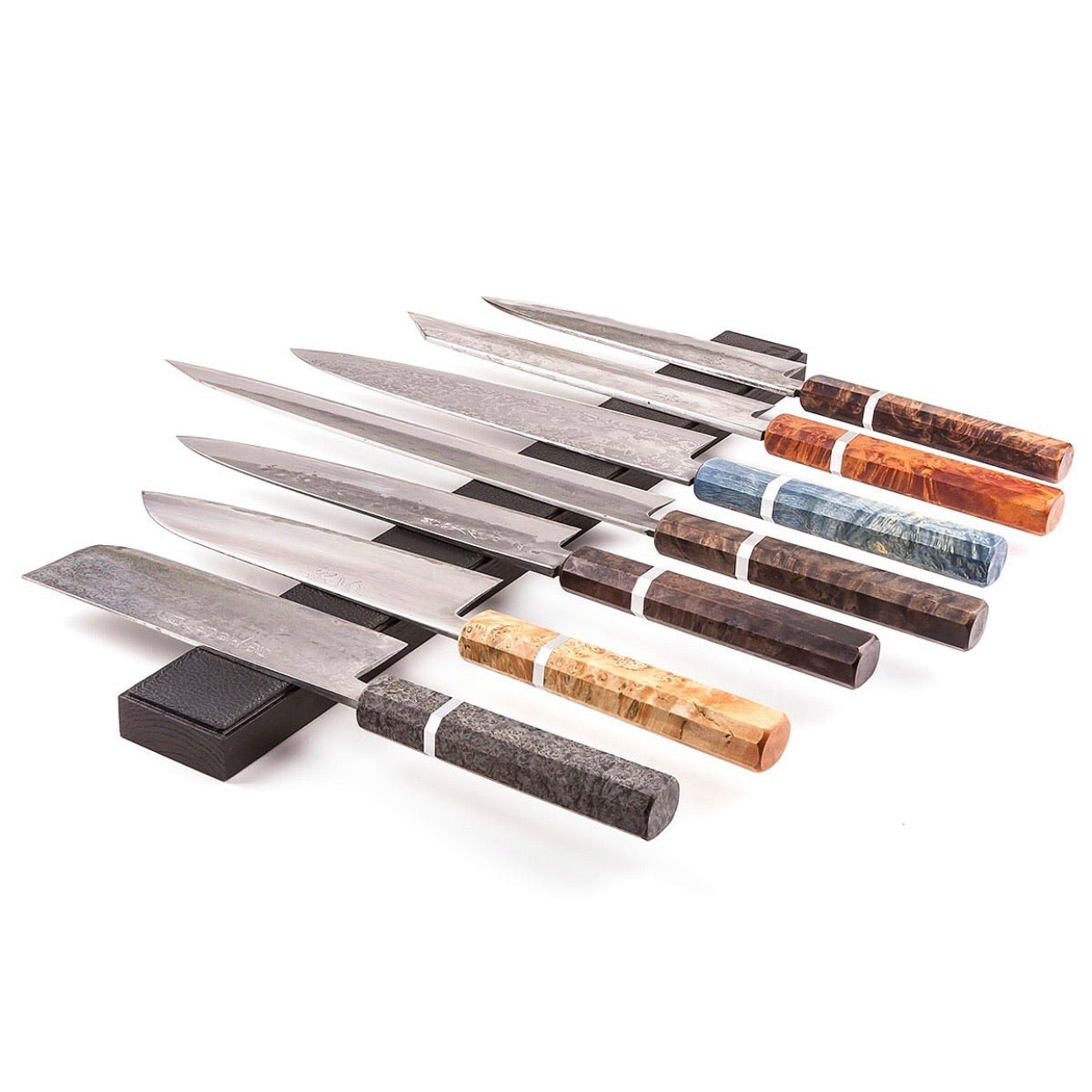
Knife Storage And Organization
Magnetic Wall Strips
Magnetic wall strips are a great way to showcase and store your cutlery. Wall-mounted storage can save counter space too. When removing a knife from the magnet, it is recommended to gently twist the handle, bringing the cutting edge of the knife away from the strip first. Then the knife will come away easily and avoids scratching your knives if the magnet or metal is exposed. (Sometimes the magnets are covered in leather or they are hidden within wood). This order of operations will also help keep the leather or wood from cuts and scratches. When placing a knife onto the magnet, ever so slightly turn the knife's spine toward the strip first. This will keep the knife's cutting edge from damaging the strip.

Knife Storage And Organization
Knife Blocks
Knife Blocks come in several sizes, styles, and orientations. They can have magnets or, more traditionally, slots to accommodate the knife’s blade. Some claim that traditional blocks with slots can dull your knives. This is technically true to a small degree, but not necessarily, to a noticeable extent. The bigger concern is that these slots can harbor bacteria and germs. It is always suggested to put knives away, washed and completely dried.
In-drawer knife blocks are a great way to organize your cutlery and help open up more counter space. They keep the blades from banging against one another or other utensils. Always put knives away clean and dry, so the slots don't breed germs and bacteria.

Knife Care
How To Care For Your Steel
Learn maintenance tips to prevent rust, cultivate a protective patina, and achieve the perfect sharpness. Whether you have low-maintenance stainless steel or high-maintenance carbon steel knives, our advice ensures longevity and peak performance for your culinary tools.
Click Each To Learn More
Stainless Steel - Little to no stain
For steel to be considered stainless, it must have a minimum of 13% chromium by weight in the alloy recipe. Keep in mind that stainless steels can rust in adverse conditions. Simply explained, and why it is important, is that the added chromium bonds with oxygen from the air, creating chromium oxide. Essentially a clear hard "skin" that adheres to steel. If this skin is damaged ie; by scouring pads, then the exposed steel can rust before the skin repairs itself, which takes about 24 hours. That’s another reason to never put any knife into a dishwasher, or even allow it to drip dry. Furthermore, the high heat and water jetting conditions will wreak havoc on the handle. Typically, stainless knives require less care since they don't easily rust.
Carbon Steel - Reactive To pH
High-carbon steel knives are reactive to anything that has an acidic pH, and are prone to rust. The blades will spot and stain forming a patina. This patina, which is a light layer of oxidation. A healthy cultivated patina will help act as a protectant against rust. Furthermore, as the patina develops, it gives the knife a unique beauty.
Depending on the alloy, carbon knives will rust at varying rates. It is important to wipe the blade dry during heavy use and after washing. If rust forms, remove it by using a rust eraser or a fine grit wet/dry sand paper. Avoid heavy abrasives like metal scouring pads or the abrasive side of a sponge which can deeply scratch the carbon blade and create a place for water to sit which will promote heavy rust and potentially leave permanent damage.
Never put a carbon steel knife through a dishwasher, let alone any knife for that matter. This will heavily rust the blade. When storing carbon-steel knives, it is recommended to use a light coat of Tsubaki oil or mineral oil. It protects the steel from humidity. These food safe oils will not get tacky when exposed to air for long periods of time and will not turn rancid.

Knife Care
Sharpening - Equipment And Frequency
For at-home chefs who cook a lot and don’t sharpen their own knives, having them sharpened every three to six months is recommended. Professionals know to sharpen often. If you are sharpening your own knives, we suggest increasing the frequency. The more often you sharpen, the less amount of work and steps are required. Sharpening by hand on stones will put the best edge on a knife but takes considerable skill and practice. If this method doesn’t appeal to you then consider a pass through sharpener. They are not all created equal though. For manual, ones that have a wheel are the best. Whether manual or powered, only use about a pound of downward pressure. Allow the device to do the work and don’t force it.
Sharpening stones come in varieties. There are water stones, oil stones, and dry stones. These can be natural, synthetic, or diamond. Each type comes in an array of grits, delineated from rough grits to medium grits and fine grits. Sharpening by hand on stones can be simple or taken to the Nth degree. If you prefer to keep it simple, we recommend using a 1,000 grit stone. It is rough enough to sharpen. Yet, smooth enough to leave a refined edge. This means that you would have to sharpen regularly since a 1,000 grit stone doesn’t have strong cutting power. If your knife is dull, it’s best to start with a rough stone, 200 to 400 grit. Always make sure to jump in modest successions for the grit count. For example, don’t sharpen on a 400 grit, then move directly to a 3,000 grit. It would be best to split the difference and use a 1,000 grit in between. As important as it is to use a sharp knife, It’s equally important to care for your sharpening equipment. Always maintain a flat surface on the sharpening stone by fixing (lapping) the high-points once the surface becomes dished. Always follow manufacturer directions of storage, care, & maintenance.
Always use caution when sharpening on powered equipment such as belt sander, and grinders. They can easily remove too much metal which can change the profile and shape of your knife. Another danger to avoid is overheating the steel. This will remove the temper and make the blade soft where it won’t hold its edge.
Learn Center
- Choosing a selection results in a full page refresh.
!

